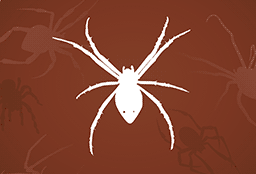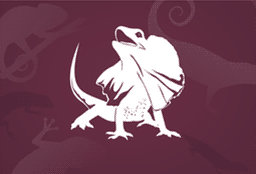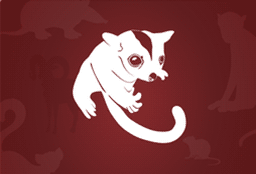Black and white, with the pattern varying across its range. The back of its neck, upper tail and shoulders (on its wings) are white in males and grey in females, and (across most of Australia) the rest of its body is black. In south-eastern, central and south-western Australia, including Tasmania, its back and rump are entirely white. Its eye is red-brown. Young birds are usually grey rather than black and have dark eyes.
Distinctive feature
One toe faces backwards and three face forwards. It has a square-tipped tail.
The caterpillar (larva) is initially pale yellow with fine hairs, before turning green. It has narrow yellow lines on its body which are sometimes hard to see. The upper side of the butterfly (adult) is white with a black tip on its forewing (front wing) and a black patch on the front edge of its hindwing. A male has one black spot on its forewing, while a female has two black spots. Looking from underneath, the forewing is white with two black spots and the hindwing is yellow.
Size
Caterpillar about 3.5 cm; Butterfly up to 5 cm wingspan.
The Christmas Spider is known by several other names, most commonly Jewel Spider but also as Six Spined Spider or Spiny Spider.
Females have bright yellow and white patterns with a ring of black spines. Melanic females have the same shape but may be completely black. Males have smaller spines and have a yellow, brown, white and black pattern. Six spines protrude from the sides and bottom end of the abdomen.
Size
Females are larger at 7 mm, males are 4 mm.
The adult male is black with a deep-orange to yellow beak, a narrow orange to yellow ring around its eye, and dark legs. The female is grey-brown, with some streaks or mottling, and its back is darker than its belly. The female also has a paler chin than the male, a dull yellow-brown beak, dark legs, and the ring around her eye is less bright. Young birds are also brown but with lighter underparts and a dark grey or black beak.
Size
25 to 28 cm (from head to tail)
The caterpillar (larva) is initially a pale yellow-grey, before turning green with long black hairs along its body. Its head is brown-black with short hairs. The female butterfly (adult) is orange with creamy yellow and dark brown patches towards the tip of its forewings (front wings). The male is less colourful, being brown and orange with no pale patches. It also has an obvious raised vein in the middle of its forewing. Both males and females have a small eye-spot on each wing. The undersides of the wings in both the male and female are paler with faint markings, and their hindwings have very few markings. The female’s hindwing is darker then its forewing. It is difficult to identify these butterflies when they are resting with their wings closed. The males emerge quite a while earlier in the year before the females.
Size
Caterpillar about 3.5 cm long; Butterfly wingspan 5.5 – 7.5 cm (females are larger than males).
Black and white, with the pattern varying across its range. The back of its neck, upper tail and shoulders (on its wings) are white in males and grey in females, and (across most of Australia) the rest of its body is black. In south-eastern, central and south-western Australia, including Tasmania, its back and rump are entirely white. Its eye is red-brown. Young birds are usually grey rather than black and have dark eyes.
Distinctive feature
One toe faces backwards and three face forwards. It has a square-tipped tail.
The top of the adult male's head is grey-black, extending in a line down either side of its white breast. Its throat is also white, with a rufous patch in the centre. Its wings and lower back are dark metallic grey and its upper back and underneath are buff. In flight, its white outer tail feathers are visible. The female has similar but duller colouring. A young bird has less distinct markings with dark olive on top of its head, a white chin and throat and a cinnamon chest and belly.
Distinctive feature
It has a very long, fine beak that curves downward.
It has a grey back and head, and bright-yellow underparts. Southern birds have an olive-yellow rump, while birds in northern Australia have a brighter yellow rump. Its throat is off-white and when seen in flight, it has a pale bar on its wings. Its bill is black. Young birds are rufous-brown with paler streaks.
Size
13 – 17 cm long, the males are slightly larger
Dark slate-grey on its head, back and wings, and pale orange-brown below; its undertail is boldly barred black and white. Its legs and feet are dull yellow and its bill is black. Young birds are duller and browner, with mottled markings, especially on their breast and underparts.
Distinctive feature
A yellow eye-ring which is tinged green in young birds.
Grey-brown to bronze, with a dark stripe running along each side of its body from its nostril, across its eye to its tail, getting wider from its front legs. Its body pales below the stripe to a cream belly.
This species has a lighter body with a less obvious stripe running along its sides than the Southern Garden Skink.
Size
8 - 10 cm (nose to end of tail).
Grey-brown to bronze, with a dark stripe running along each side of its body from its nostril, across its eye to its tail, getting wider from its front legs. Its body pales below the stripe to a cream belly.
This species has a ‘heavier’ looking body and a more obvious stripe running along its sides, compared to the Northern Garden Skink.
Size
8 - 10 cm (nose to end of tail).
Its head and upperparts are mostly dark grey, with a white eyebrow and throat, a narrow grey band across the upper breast and a creamy-buff belly. The feathers of its long tail have white edges and tips, and the tail is often fanned out.
Size
14 – 16 cm long
Dark grey to brown body, with lighter grey fur on its head and golden-orange fur encircling its neck. Its wings are black.
Distinctive feature
Fur on its legs that extends to its ankles.
Size
23 cm to 29 cm head and body length); wingspan over 1 m.
Deciduous tree, up to 35 m high, but much smaller when grown in gardens and in cooler areas where it reaches a height of only about 10 m. It can take 5 – 8 years to flower if grown from a seed.
Leaves
Smooth, oval-shaped and can have three or five lobes (and sometimes more). Each leaf is 10 – 30 cm long. The tree loses some or all of its leaves at the end of winter, before flowering, and the leaves turn yellow just before falling.
Flowers
Bright coral-red and bell-shaped, they occur in clusters at the end of branches. They are 1 – 2 cm long and have a waxy surface. They appear after the tree has lost all or some of its leaves.
Deciduous tree, growing to 15 – 30 m high and 15 – 20 m wide. Some of its grey-brown bark peels off to reveal a creamy white inner bark, giving the trunk a mottled appearance.
Leaves
Mid-to-dark green with 3 – 5 lobes and slightly serrated edges. They are 10 – 25 cm across and turn yellow-brown in autumn. The leaf lobes are about as wide as they are long.
Flowers
Red or yellow, in small rounded clusters. The red (female) flowers grow from the newer shoots and the yellow (male) flowers grow from older branches further back toward the trunk.
A black and white bird, the pattern varies slightly between sexes. The male has a white eyebrow above a black horizontal eye-stripe, a black face and throat, while the female has a white face and throat, with a broad vertical stripe through the eye, and no white eyebrow. Both sexes have a thin white bill and black legs and feet. Juvenile Magpie-larks have a black forehead, white eyebrow and a white throat.
The top of its head and its hindneck are black. Its forehead is covered with bright-yellow skin, which hangs down to form wattles. The rest of the head is white. Its back and wings are pale grey-brown. Below, black plumage extends from the hindneck onto the sides of its breast, and the rest of the underparts are white. Its long legs and feet are reddish and its bill is yellow. It has a prominent spur on each wing.
Juveniles are similar to adults, but have dark ‘scallop’ markings on the back and wings, and the wing spur and wattles are either smaller or absent.
Distinctive feature
A yellow wattle that extends from its forehead to behind its eye and hangs down beside its chin.
The caterpillar (larva) is initially green, white and brown and resembles bird droppings. A mature caterpillar has a dark brown head, a green body with some pale yellow and brown markings, and spines along its back.
The male butterfly (adult) is black with an arc of creamy-white spots near the tip of each forewing. Each hindwing has a creamy-white patch and a single red spot, and there are many red crescents on its underside.
The female butterfly is brown to black, and the outer half of its forewing is whitish-grey. Its hindwing has a creamy-white patch, as well as a series of blue and red crescent-shaped markings.
Size
Caterpillar up to 6 cm long; Butterflies 10 – 12 cm wingspan.
Black and white, with the pattern varying across its range. The back of its neck, upper tail and shoulders (on its wings) are white in males and grey in females, and (across most of Australia) the rest of its body is black. In south-eastern, central and south-western Australia, including Tasmania, its back and rump are entirely white. Its eye is red-brown. Young birds are usually grey rather than black and have dark eyes.
Distinctive feature
One toe faces backwards and three face forwards. It has a square-tipped tail.
A colourful bird, the upper part of its back is bright green, merging to light blue on the lower part to its rump. Its tail is black, tinged with blue, and has two long central feathers (called streamers) that extend beyond the tip of the tail. Its forehead is blue-green and the top of its head is golden. A bold black eye-stripe runs from the base of its beak and is bordered below by a narrow blue line. Its chin is yellow, changing to chestnut on its throat, below which is a broad black band. It has a green breast, becoming paler on the belly and changing to light blue from the lower belly to the vent. It has a long, slim, curved black beak and its legs and feet are grey-black.
Young birds are generally duller and greener. They lack the black band across the lower throat and the long tail streamers.
Distinctive feature
The sexes differ in the length of their tail streamers: the male has longer, more slender streamers.
A tussock-like, rosette plant. Tussock size up to 30 cm high and wide with a flower stalk up to 1 m high.
Leaves
Long, sword-shaped and forming a clump. Each individual leaf is 8 – 20 cm long and 1 – 3 cm wide and usually stands upright. There are 5 veins running down each leaf.
Flowers
Small and initially cream, but turn brown rapidly. They grow on top of a ridged, 1 m high flower stem growing from the centre of the tussock of leaves. The flowers form a tight, cylindrical cluster which is 1 – 7 cm long.
Named in 1830 by explorer and botanist, Allan Cunningham. The genus name Grevillea honours Charles F Greville who co-founded the Royal Horticultural Society, and the species name robusta refers to its large size.
Evergreen tree usually grows 20 – 30 m tall but can range from 8 – 40 m in height.
Leaves
Silvery green and fern-like, green on the upper surface and paler underneath. They are 10 – 34 cm long and 9 – 15 cm wide, and consist of 11 – 31 segments that are narrow-elliptic to triangular in shape. The segments are 1.5 – 5 cm long and 2 – 10 mm wide, and they give the leaf a deeply divided appearance.
Flowers
Golden yellow to orange, each one is about 2 cm long but they are arranged in pairs along the flowering stalk to give an overall length of 12 – 15 cm.
This spider is named for the cross the female weaves into the web. There are many theories about why the female does this including, strengthening the web, for camouflage, and for increasing prey catches as the cross reflects ultra-violet light which attracts insects. It may also deter predators which must go to the effort of cleaning off the extra silk after diving into the web.
The female has a silvery head with silver, yellow, red and black bands across its abdomen, and two yellow stripes running down its underside. Its legs are dark brown to black with one or two yellowish bands. The male and juveniles are brown and cream, with brown legs. It often appears to have only four legs because it sits with its legs in pairs along the stabilimentum.
Distinctive feature
The zigzag patterns (known as the stabilimentum) it weaves into its web to form an X or a cross, after which it is named.






